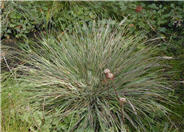
Common name:Santa Barbara Daisy, Mexican Daisy
Botanical name:Erigeron karvinskianus
This low mounding perennial, with fine leaves and white to pinkish daisy-like flowers, is an excellent asset to rock gardens. Capable of spreading.

Common name:Blue Moor Grass
Botanical name:Sesleria caerulea
This grass will grow to about 18-24"H x 18-24"W. It has blue/green or gray/green leaves.

Common name:Common Yarrow, Milfoil
Botanical name:Achillea millefolium
Highlighting this perennial are spreading mats of fern-like rosettes, along with deeply divided leaves of a green or grey green color. In this form, the flowers are usually a white tone. Stems can reach 2-3ft above foliage. The yarrow propagates easily from rooted cuttings or division, which should be performed in the early spring or fall. Following bloom, one should dead head the plant and divide the clumps when it appears crowded.

Common name:Reed Grass
Botanical name:Calamagrostis foliosa
This tufted perennial bunchgrass is native to the northern California coastal scrub. It forms a beautiful, dense mound of grey greeen leaves that reach 2' tall, with showy arching flower stalks to 3' tall. Reed Grass leaves assume an attractive purple coloration in the fall and winter. This evergreen should be grown under sun, with little or no summer watering required. -Monterey Bay Nursery

Common name:Berkeley Sedge
Botanical name:Carex divulsa
A fast growing vibrant green clumping sedge to 2' tall and wide. Widely adaptable, can be planted in wet soil or arid soil, tolerates sun to partial shade and can be drought tolerant. Tan to brown flowers show in spring.
| Designer: | Natural Rock Setting |
Photographer: GardenSoft |
Soils and Compost:
Practice grass-cycling by leaving short grass clippings on lawns after mowing, so that nutrients and organic matter are returned to the soil.
Water Saving Tip:
Water trees and shrubs by deep-soaking occasionally with low-volume irrigation equipment (drip, micro-sprays, or bubblers) to promote healthy, deep rooting.
Integrated Pest Management:
Remove irrigation water and fertilizer from areas where you don't want weeds to grow.
